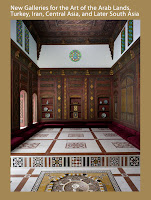Highlights of the collection include: the sumptuously ornamented Damascus Room; some of the finest classical carpets in existence from the 16th and 17th centuries; notable early and medieval Qur’ans; and architectural elements including a 14th-century mihrab, or prayer niche, from Isfahan decorated with glazed ceramic tiles, which would have served in a Muslim house of worship to indicate the direction to Mecca. There is also a beautiful pair of minbar doors, which lead to a podium used in mosques by imams to deliver sermons.
I'm personally obsessed with the astrolabes - can't I find one on ebay? Check out the one made in 1291! I've also spent enough time in Turkey, Egypt, and the Haight to know what a huqqa is, but I've never seen a base quite as pretty as the one below from the 17th century with the irises. There is also the coolest, most modern looking chess set ever...from the 12th century. And finally, who doesn't need their own golden Goa Stone container? Goa Stones were manufactured by Jesuit priests living in Goa, India. They are manmade versions of bezoars (or gallstones), that when scraped or ingested with tea or water were supposed to have medicinal properties. Elaborate containers of gold or silver were made for them with intricate carvings of unicorns and griffins, perhaps influenced by Portuguese sailors.













No comments:
Post a Comment